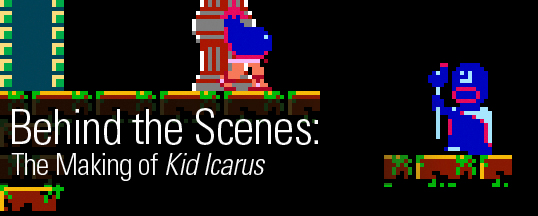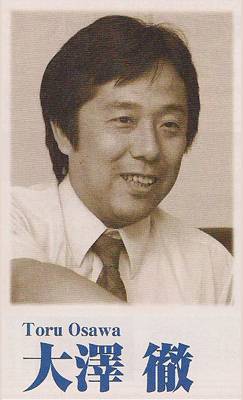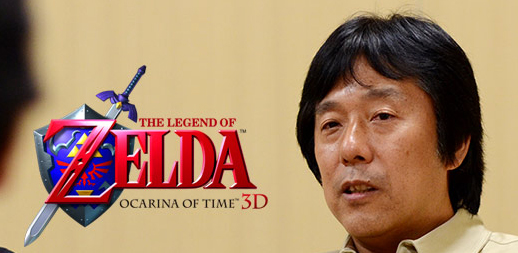Part 5: The Making of Kid Icarus

Uprising is a pretty good game, control issues aside. But it wasn't conjured out of thin air: Sakurai has mentioned time and again how he took precedent from the first game in the series throughout production.
So how did that first game come about? Well, it almost didn't.
Kid Icarus did not have an easy production cycle. It was beset by problems of all kinds and the fact that it was completed on time is something of a small miracle. A miracle primarily generated by one man.
This man.

Please take a good, long look at him. Memorize his face.
It's cool, I'll wait. No rush.
Done?
Good.

In the late 1980's, Nintendo was a wild and crazy place. Lowly staff artist Shigeru Miyamoto had just made the company heaping wheelbarrows of money with the runaway hit Donkey Kong despite having no serious experience in game design. Other Nintendo employees were inspired: if Miyamoto could create a hit, anyone could. Game development requests began flying into management's inboxes as every small-time programmer and pixel artist tried to grab success with their new game idea.
Toru Osawa was one such hopeful, a neglected, low-ranking employee with big dreams. He pounced on the can-do attitude within the company at that time and asked upper management if he could create a game. High on the spirit of their own success, the management consented.
At the time, pretty much all of Nintendo's development staff were busy making a kooky game with flying jellyfish called Metroid. None could be spared for another game project, so Osawa was essentially forced to create his new game alone. Management cared little about this, dropping a non-negotiable December 19, 1986 release date in his lap with little more than a cheerful "Good luck, Chuck!"
Osawa wasn't deterred. He put together a unifying design document, drew sprites, and
Unfortunately, his efforts weren't enough. By August 1986, Metroid had been fully completed while Kid Icarus was still struggling through the prototype stages, with Osawa only just getting the running and shooting mechanics working properly. It was apparent that no matter how much effort he put in, he couldn't finish the game alone in the timeframe given. Unaware of this, the Metroid development team took a vacation.

Salvation arrived when Yoshio Sakamoto, one of Metroid's directors, returned to the office from his vacation. He found Osawa slaving away on his barely-half-finished game and grew alarmed. Calling back the rest of the Metroid programmers from their vacations, Sakamoto enlisted as many of them as he could to help Osawa finish his game in time for the release date, three months away.
What followed was nothing short of grueling. For three months, programmers and artists were unable to leave the office due to all the work that needed to be done. What little sleep they achieved was done on top of crushed cardboard boxes, but even an explicitly written sign begging everyone to let them sleep for a few hours wasn't enough to keep them from being woken up early for more work. Osawa got married during this time but could only spare three days for a honeymoon. During the middle of his second day, Sakamoto was forced to call him back to the office. The code had to continue flowing no matter what; nothing would stop this train.
Things grew really tense when December arrived. With a half-month left to go, Osawa and his fellow developers spent every possible moment getting the game into a playable state. The only reason they succeeded was because Nintendo's factories were good enough to mass-produce an entire run of game disks for their Famicom console in three days. On December 16, Osawa was given an ultimatum: if there were no major game-crashing bugs, the game had to be shipped.

The extreme time crunch resulted in an odd, quirky game. Difficulty during the early stages was severe and decreased in later stages, the result of very little playtesting or balance tweaks. The screen could only scroll upwards, not downwards, as the protagonist Pit made a continuous climb up to the heavens: despite being an angel, he couldn't fly, except for a new gameplay section shoved in at the last possible minute. The enemies had random, bizarre designs with no unifying theme: one of them turned the player into an eggplant. Osawa put it in at one point in celebration for getting a summer bonus paycheck, and because he really liked eggplants. Nobody questioned this. Finally, there was no credits roll at the end of the game, simply because there was no time to make one.
Kid Icarus met its deadline, despite all odds. But the person who sacrificed most to get it there would go unrecognized: it was common practice at the time to misrepresent or outright omit developers from the staff credits in Japanese games to avoid letting said developers be stolen by headhunters for rival companies. As such, the American version of Kid Icarus that was released later on for the NES had staff credits, but Osawa wasn't listed in them.
Toru Osawa still works at Nintendo, making games and taking names. His most recent work was a General Director role in the 3DS remake of The Legend of Zelda: Ocarina of Time.

Remember this man, okay? Because someone ought to.
If you would like to know more about the wild and crazy ride of the Kid Icarus development cycle, there's a cool article on it over at Nintendo World Report. Check it out when you're in the mood.
A jargogle posted:
I heard that the the localisation for the west was really quite sweeping and may even have changed the overall "tone" of some of the characters?
Pretty much, yeah.
Sakurai posted:
[The Japanese script] is something that takes advantage of the nuances of Japanese conversation, and not all of it works directly in English. We had NOA handle the localization, and I told them to change the meaning and content as much as they want - that I wanted conversations that sound natural and enjoyable to a native speaker.
This came from an interview with IGN where Sakurai also confirmed there will be no sequel to Uprising. Instead he suggests we'll wait another 25 years for another director to pick up the series again. Laments abound!